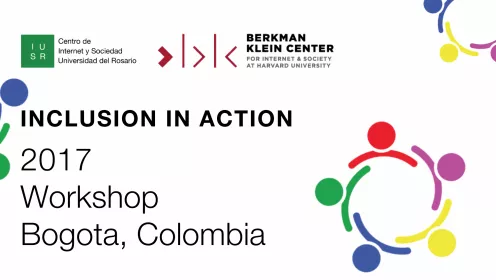
Inclusion in Action
Inclusion is a key process for sustaining, developing, and building democratic societies. Crossing multiple social dimensions, inclusion can help to ensure more equal opportunities for participation and access to markets, services, and spaces. At its core, inclusion is about “improving the terms for individuals and groups to take part in society” (World Bank, 2013). Inclusion matters because it allows us to recognize diverse groups and identities (e.g. ethnicity, race, gender, religion, national origin, location, age, educational attainment, and/or socioeconomic status), and understand that not all individuals and groups have equal access to opportunities and/or avenues of participation. Moreover — as extensively discussed at a recent global symposium organized on behalf of the Global Network of Internet & Society Centers by the Institute for Technology and Society of Rio de Janeiro and the Berkman Klein Center for Internet & Society — in the context of rapid technological change and digital transformation, fostering inclusion is essential to avoid deepening existing inequalities.
Last October, the Centro de Internet y Sociedad de la Universidad del Rosario (ISUR), represented by Julio Gaitán, and the Berkman Klein Center, represented by Sandra Cortesi and myself, co-hosted a highly interactive one-day workshop in Bogota to discuss and map the challenges and opportunities around inclusion in Colombia, and to explore ways of cultivating a more participatory and democratic future. With forty-five representatives from different sectors (e.g. academia, civil society, and government) participating in a series of interactive activities, the “Inclusion in Action” workshop allowed us to co-create a space for the meeting and exchange of diverse voices and perspectives.
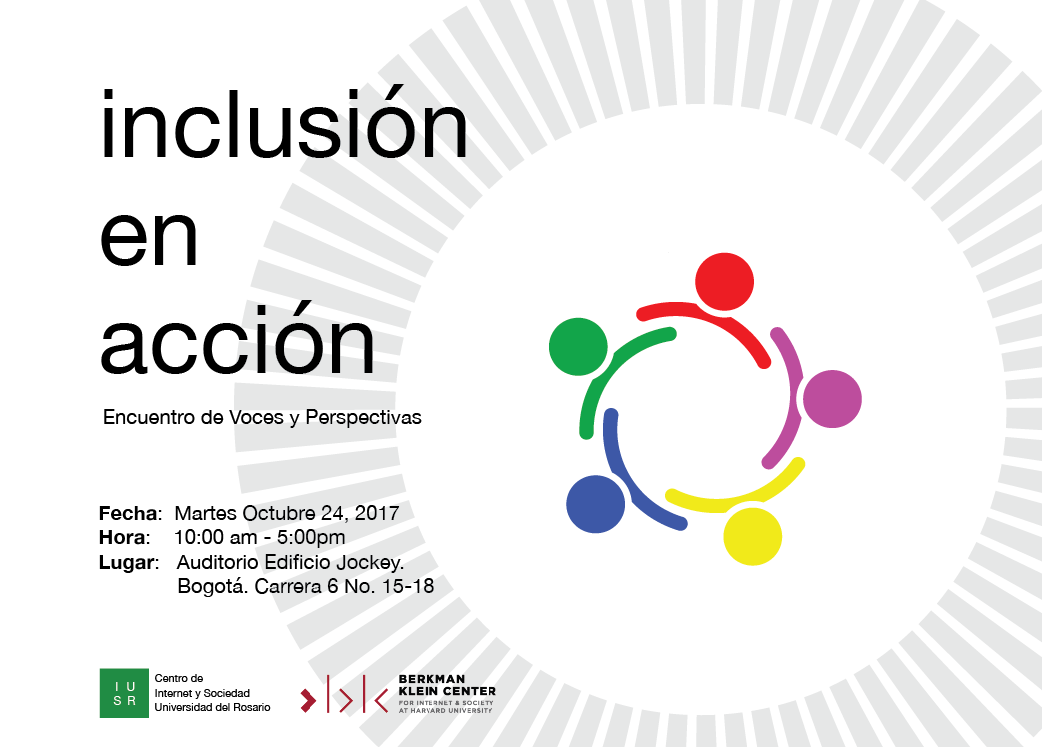
Inclusion in the Colombian Context
The particular post-conflict context of Colombia has placed inclusion at the center of a variety of projects across multiple sectors. After more than 60 years of civil war followed by a peace deal signed in 2016 between the government and the Revolutionary Armed Forces of Colombia (FARC), the country now has the opportunity to reinvent itself. In this scenario, inclusion has become essential for the re-imagining of Colombia as a more democratic society where diverse groups and individuals can participate in and access the domains of politics, education, economy, and culture.
Increasing participation across multiple dimensions and including the voices of minorities and underrepresented communities such as Afro-Colombians, indigenous people, at-risk youth, and women has become a pressing challenge and one of the central themes of the peace agreement. Similarly, designing strategies and programs for re-integrating over 7,000 FARC combatants (of whom around 40% are women) into civilian life, and ensuring they have access to opportunities and participation, is central to the post-conflict process and the implementation of the peace deal.
Multiple stakeholders are supporting inclusion processes in Colombia at the local, regional, and national levels through the development of a wide range of interventions. These initiatives include programs that expand access to financial services in rural areas, developed through a collaboration between the government and the private sector; civic journalism projects created in local libraries by youth collectives; and educational programs for women around Internet usage facilitated by NGOs. The Inclusion in Action workshop aimed to create an open space to learn about a variety of projects, exchange ideas, meet potential collaborators, and work together in the identification of pressing challenges and potential opportunities for inclusion.
Spaces for Learning, Networking, and Researching: Introducing ISUR
The one-day workshop served as the public launch of the Centro de Internet y Sociedad de la Universidad del Rosario (ISUR). The co-organizers of the workshop spent more than a year incubating this center, the first of its kind in Colombia. In a country with 57.6% of Internet broadband penetration, social media users on the rise (e.g. 17 million daily active Facebook users in 2017, particularly youth), and a growing ecosystem of innovation, it has become crucial to research and understand the challenges and opportunities of the digital era.
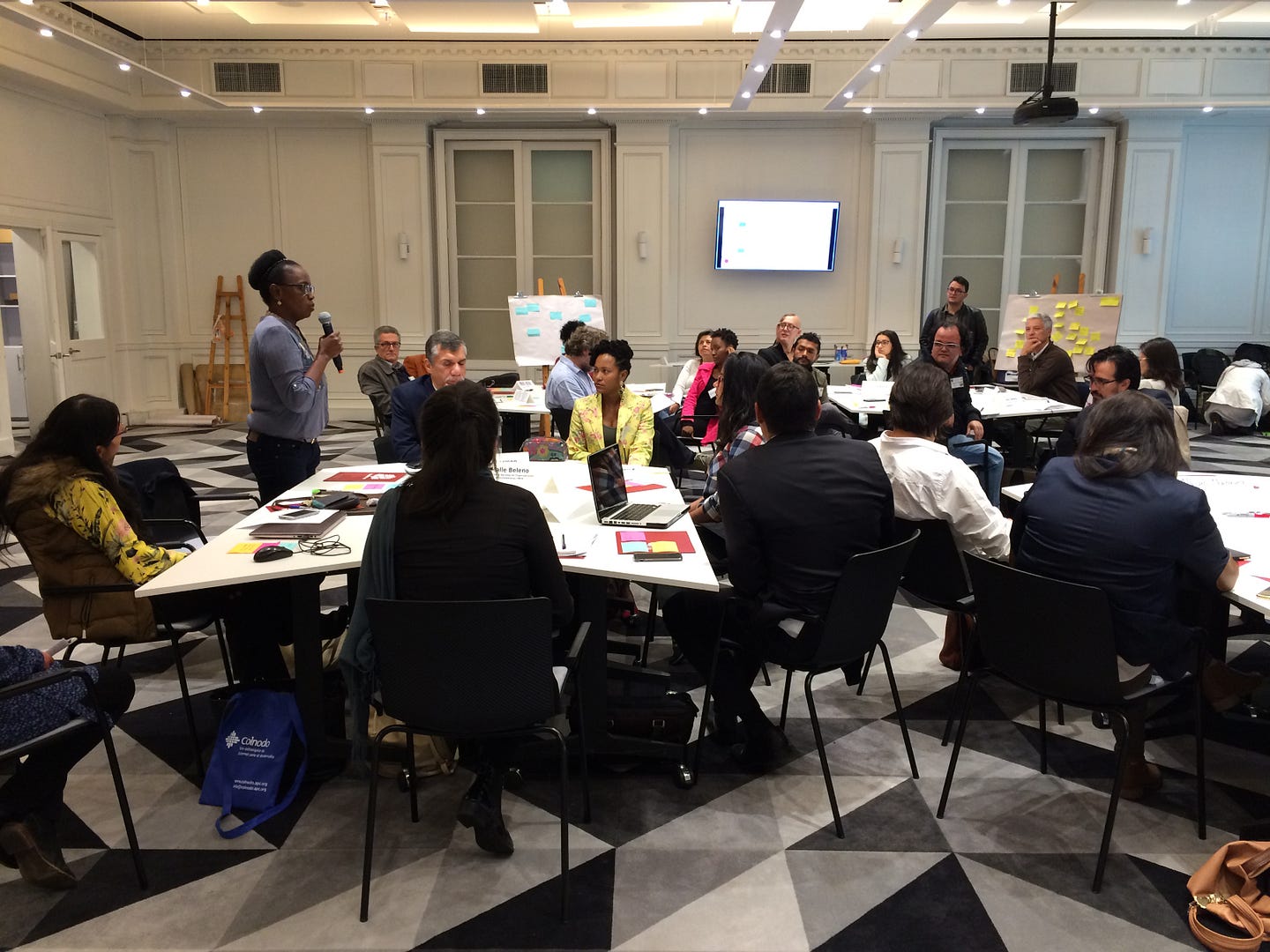
Dorina Hernandez from San Basilio de Palenque talking about Mujeres Palenqueras at the workshop.
Part of the mission of ISUR is to create a space where multiple stakeholders can meet, learn, and work together. For the one-day workshop, we invited representatives of various sectors (particularly civil society and academia) that work on initiatives around social and digital inclusion across different regions of the country. We were sensitive to the gender and racial balance and tried to create a space that was diverse, safe, and inclusive. Indigenous and Afro-Colombian women from organizations such as the Organización Nacional Indígena de Colombia — ONIC (National Indigenous Organization of Colombia), and the Observatorio Antidiscriminación de Cartagena (Observatory of Anti-Discrimination of Cartagena), for instance, received travel support. Their participation, as well as that of other representatives of minority groups, enriched the dialogue within the Universidad del Rosario auditorium.
Inclusion Initiatives from Colombia
As co-hosts of the workshop, we structured it as a series of interactive sessions that included discussions, presentations, and hands-on exercises. In the morning, activities focused on getting to know others, identifying common interests, and sharing insights from inclusion projects. We tried to address the multiple dimensions of inclusion, taking into account the financial, political, educational, and technological interventions deployed in different regions of the country, exploring initiatives in both urban and rural areas. In this section, we describe a selection of them.
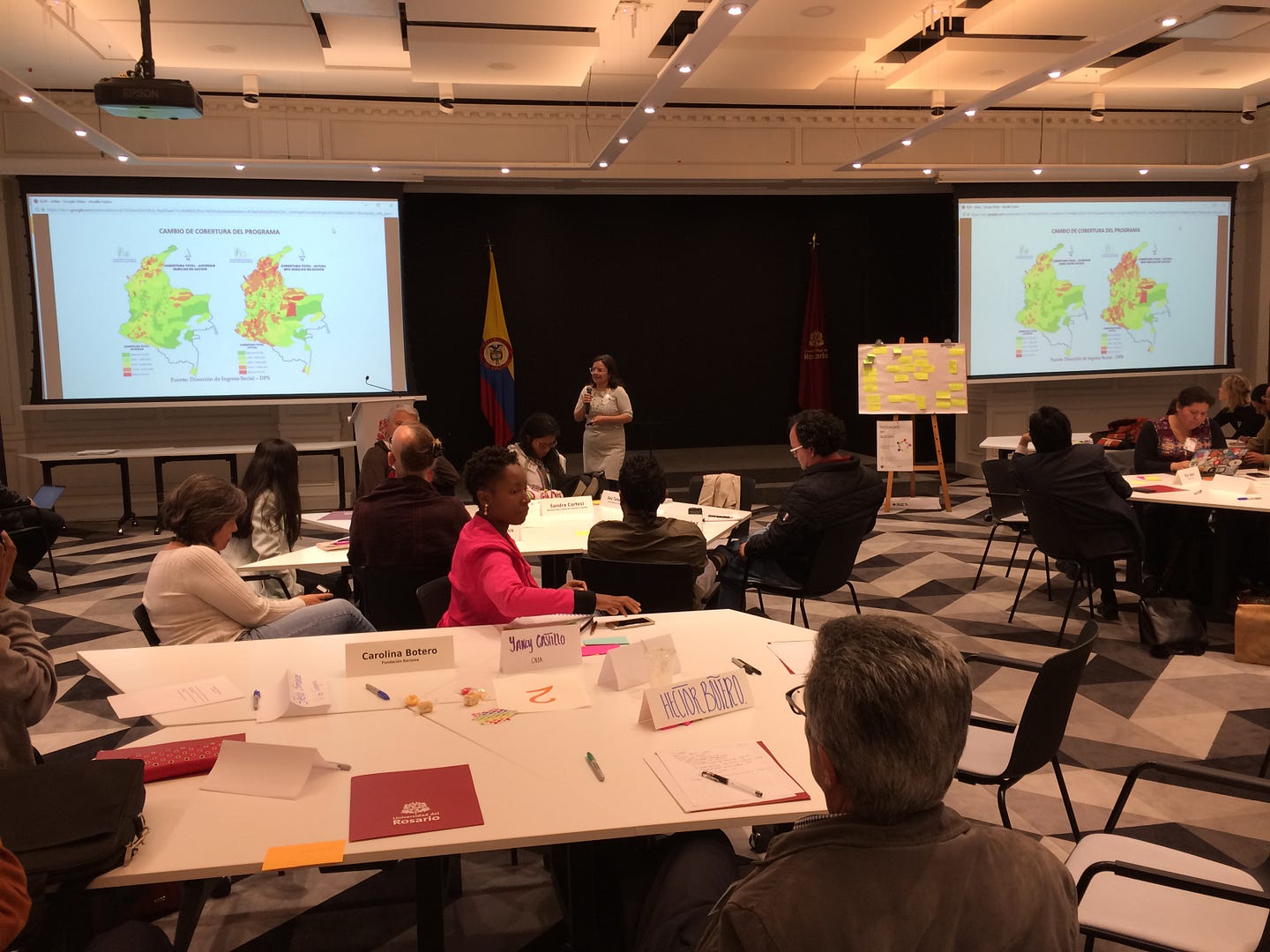
Ana Tamayo presenting Electronic Coin Purses, a cross-sector collaboration for financial inclusion.
Ana Tamayo, former coordinator of Más Familias en Acción (More Families in Action), a governmental initiative to help reduce poverty and income inequality, shared insights about the importance of cross-sector collaborations for reaching peripheral territories and marginalized populations. The case of the Electronic Coin Purses, for instance, served as an example to illustrate how public (Agrarian Bank) and private (Davivienda) financial institutions joined forces to bring financial services to Choco, one of the most impoverished Colombian regions on the Pacific Coast. These coin purses (Daviplata) allowed low-income families to receive subsidies and engage in transactions using their mobile phones. According to Tamayo, financial inclusion needs to be considered in any process of social inclusion, even if it is a long-term goal.
Gabriel Jaime Vanegas shared his experience with youth and processes of social inclusion. The community of practice and civil organization he coordinates, ConVerGentes, emerged at the public library of San Javier La Loma, a marginalized neighborhood in Medellin. The organization originally aimed to help community members resist armed conflict in the region through non-violent means (e.g. reading groups, writing workshops). To work towards this goal, a group of passionate local youth came together to engage in memory making and storytelling by leveraging the digital technologies that the library provided, such as computers and Internet connectivity. HiperBarrio, the first project they created, was a hybrid between an online platform and a social laboratory, and it allowed the community to train an entire generation of urban youth in the use of digital media for citizen journalism and storytelling. In 2009, Hiperbarrio received the prestigious Prix Ars Electronica for Digital Communities and acted as a leading force in helping to change the narrative of violence that characterized their neighborhood. Today, ConVerGentes develops a range of projects with local youth that include creating maps of their territory using Open Street Maps, hosting urban agricultural workshops, and developing multimedia stories for the web.
Barbara Santos presented examples of creative laboratories (“laboratorios de creación y tecnologías desde el saber ancestral”) that she is developing with the initiative Cuenco de Cera in the Colombian Amazonia. Produced in collaboration with indigenous people, these laboratories explore new pedagogies that allow two-way exchanges between ancestral knowledge and western arts and sciences. According to Santos, processes of inclusion should be bi-directional: that is, they should not only be trying to include minorities into society, but also to have the society at large recognize peripheral technologies and knowledge. By doing so, both actors can learn from each other while exchanging knowledge, technologies, and emotions. The co-creation of manuals about indigenous genealogy and sacred places from the Pirá Paraná at the Vaupes region, for instance, reveals how the laboratories could foster an inclusive process that strengthens ancestral traditions and knowledge.

Pirá Paraná indigenous community participating in Cuenco de Cera. Photo by Barbara Santos.
While sharing insights, workshop participants recognized several barriers they confronted in developing inclusion projects. Racism and sexism, for instance, were recognized as systemic problems, features of the structural inequalities that exist in Colombia. Olga Paz, from the civil organization Colnodo, explained that constructing inclusion programs in a patriarchal environment where gender roles reproduce inequalities, particularly for women, is challenging. Likewise, Stella Simancas, from the Observatorio de Antidiscriminación Racial de Cartagena, highlighted how the intersectionality of gender discrimination and racism affect Afro-Colombian women, particularly in the labor and tourist industries. Magnolia Morales Zamora, an indigenous Kankuama woman from the ONIC, pointed out that colonization was still a problem that indigenous communities confront today, and that they struggle for their right to autonomy.
Mapping Challenges and Opportunities
The second part of the workshop focused on making and doing. More specifically,it was designed around mapping opportunities and challenges for inclusion in Colombia, and imagining possible futures. For this purpose, we facilitated activities where participants worked in groups using a variety of instruments and materials.
Colombia Year 2100: Exquisite Speculative Corpses
Combining several design fiction techniques and exquisite corpse methods for collective creation, participants imagined possible scenarios for the year 2100 in Colombia. Working in teams of six, individuals produced several scenarios describing a specific space of the future (e.g., space for work, for leisure, for communication, for education, or for politics). They described the technologies that would be available in that space, the activities people would do, and how decisions would be made.
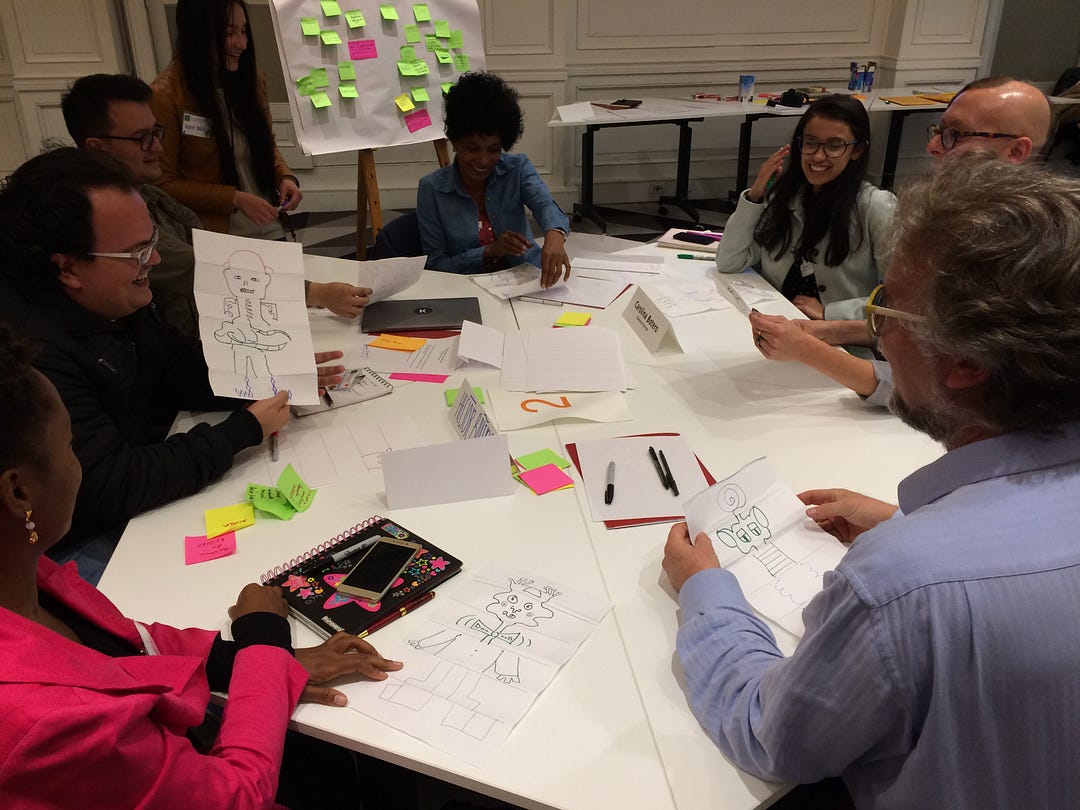
Interestingly, most of the scenarios participants created offered an optimistic view of the 22nd century in which AI, robots, humans, cyborgs, and nature coexist. One group, for instance, imagined an educational space “that is plural and diverse, where all social sectors can converge and relate to each other in equal terms.” In this space, “AI technologies are prioritized for education and for the environmental and ecological development, with an emphasis on preserving biodiversity.” Moreover, “AI technologies mix different types of knowledge: afro, indigenous, western, emotional, and body knowledges.”
Other groups imagined a cooperative space for working that was participatory and inclusive, and where “the common interest rules.” In this space, “people dedicate their time to what they like and work cooperatively with computers and robots. All work together towards progress and development, and feel acknowledged as creative and social beings.” Decisions, they wrote, “are taken by all and include collective participation.”
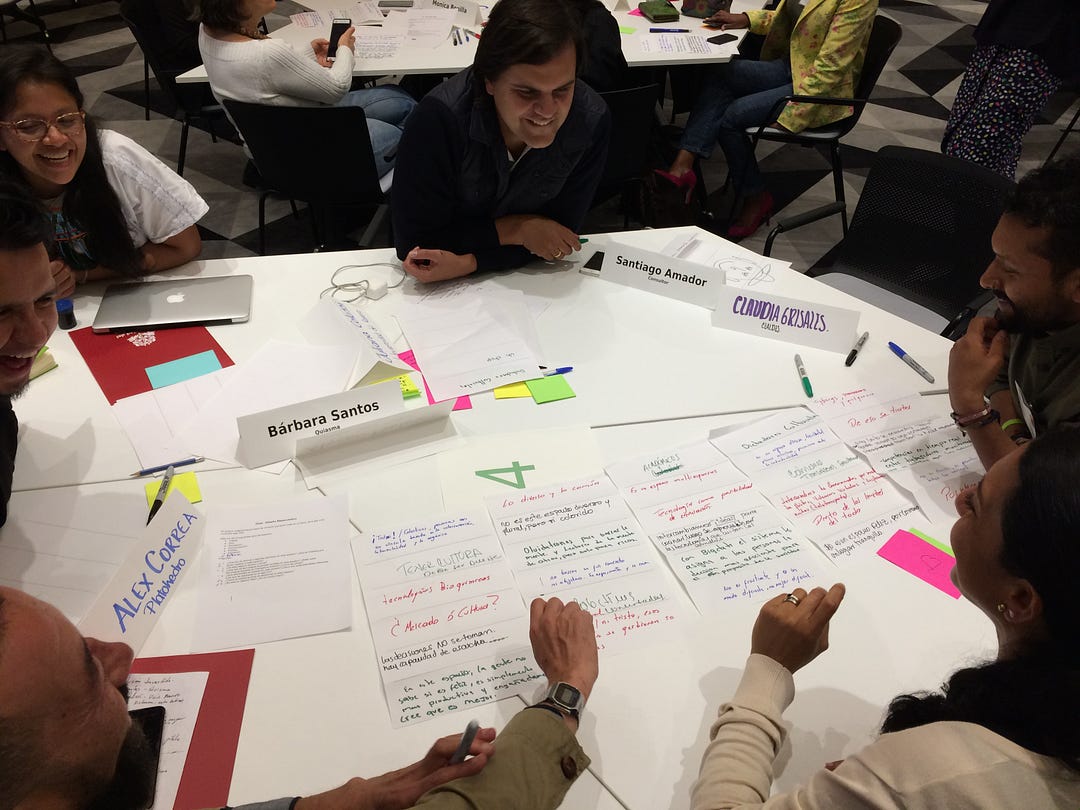
Thus, the Colombia in the year 2100 was imagined as a better world. The imagined spaces — perhaps influenced by the theme of the workshop and the participants’ work in civic organizations — were democratic, peaceful, and inclusive. Although these future spaces for work, education, and politics were rich in technology, they were also strong in participatory decision-making processes and focused on promoting cooperation among different actors.
Potential Case Studies
An interactive mapping activity helped us identify 17 potential research and intervention sites (i.e., cases), and collectively map the challenges and opportunities that inclusion processes face in Colombia. Participants identified a total of 17 potential case studies covering a variety of sectors, including tourism, transportation, financial technology, education, and public health. Each case had a concrete location and a list of actors, and was articulated through a research question and a proposal for public policy.
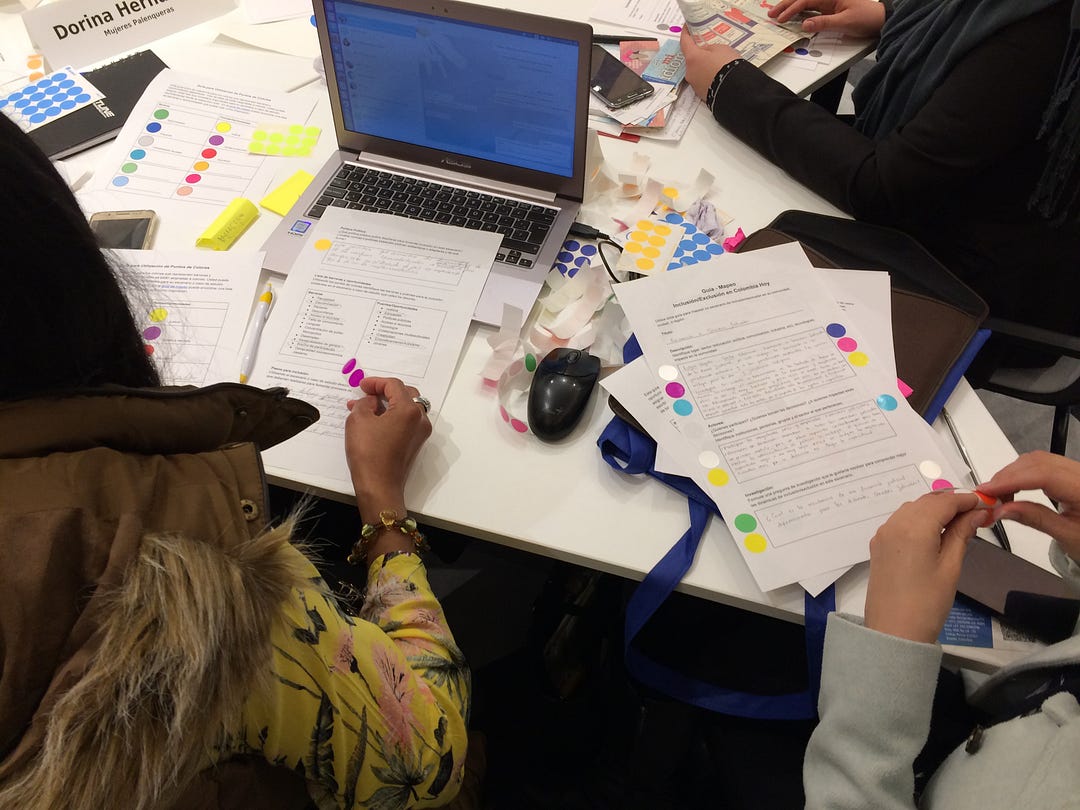
One potential case study, for instance, examined the social and digital inclusion of ex-combatant women in reintegration zones. It raised the question of how Information Communication Technologies (ICT) could foster civic participation among ex-combatants. Other potential cases explored how to use digital technologies to support the linguistic and cultural diversity of indigenous communities, and how indigenous communities could leverage digital technology to preserve their languages and culture.
Identifying the challenges and opportunities allowed us to visualize commonalities across cases. Lack of access to knowledge, racism, stereotypes, corruption, injustice, and mistrust were some of the common barriers that participants highlighted. Regarding potential opportunities, participants recognized justice, social innovation, memory building, education, and autonomy as the bridges that could help to close gaps and foster processes of inclusion.
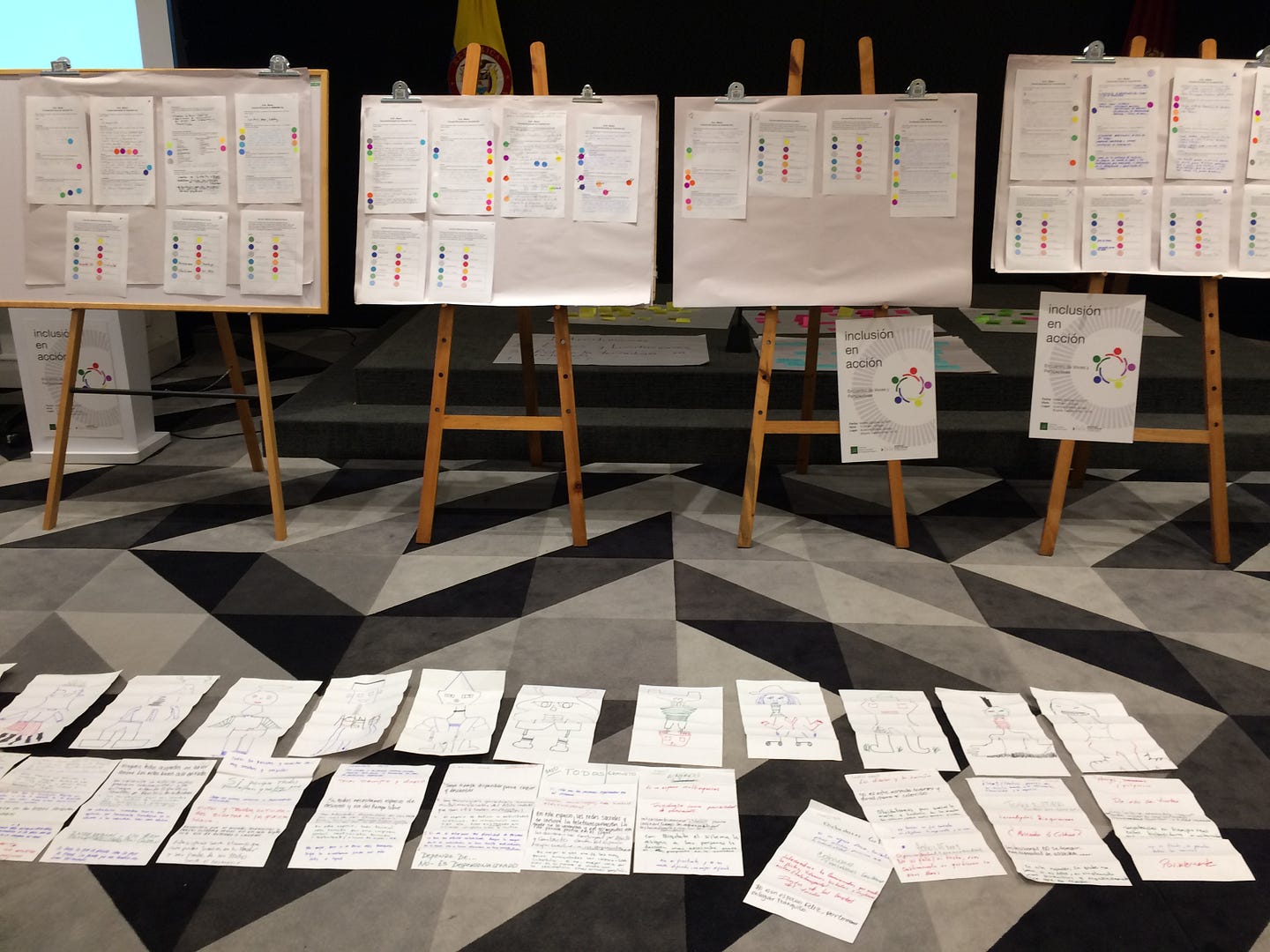
Exquisite speculative corpses and case study maps created by the workshop participants
Conclusion
With an auditorium full of content created by the participants (e.g. maps, exquisite corpses, post-its), and with our minds full of ideas, we closed the one-day workshop with a talking circle. Participants had the opportunity to reflect on what they learned throughout the day and outline future collaborations. Collectively, we acknowledged that there is an urgent need as well as an opportunity to support inclusion processes in local communities and territories. Particularly in contexts that are culturally and ethnically diverse, inclusion strategies need to be implemented across multiple sectors to help remedy structural inequalities and strengthen democracy. A core part of these strategies, as we discussed, involves expanding access to knowledge, technology, and networks. Moreover, inclusion processes also require access to spaces where diverse actors can meet and engage in productive dialogues and idea exchanges — spaces where people can learn together, organize, and build community. Co-creating a safe space at the auditorium of the Universidad del Rosario was precisely one of the most important outcomes of our workshop, and we look forward to seeing how the connections among participants thrive and give rise to future collaborations, interventions, and research projects.
